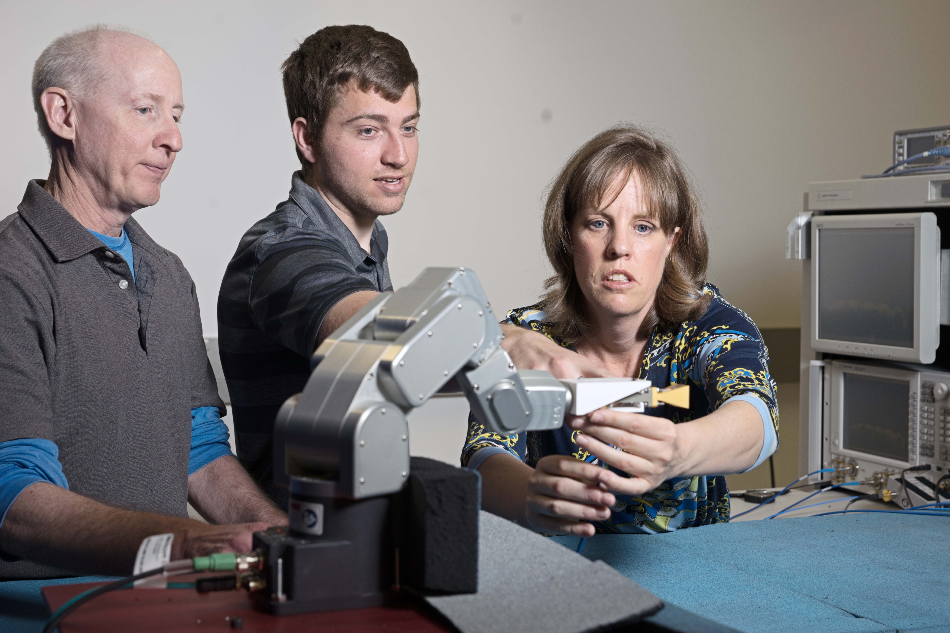Aug 11 2020
Thanks to a new portable and flexible measurement system developed by engineers from the National Institute of Standards and Technology (NIST), fifth-generation (5G) wireless communications devices that have unparalleled precision over a broad range of signal frequencies and situations can be designed and repeatedly tested in laboratories.
 Engineers Rodney Leonhardt, Alec Weiss, and Jeanne Quimby with NIST’s SAMURAI, a portable measurement system to support design and repeatable laboratory testing of 5G wireless communications devices with unprecedented accuracy. Image Credit: M. Hammer/National Institute of Standards and Technology.
Engineers Rodney Leonhardt, Alec Weiss, and Jeanne Quimby with NIST’s SAMURAI, a portable measurement system to support design and repeatable laboratory testing of 5G wireless communications devices with unprecedented accuracy. Image Credit: M. Hammer/National Institute of Standards and Technology.
Called Synthetic Aperture Measurements of Uncertainty in Angle of Incidence, or SAMURAI for short, the system is the first to provide 5G wireless measurements with a precision that can be traced to rudimentary physical standards—a crucial aspect because even the smallest errors can lead to ambiguous outcomes. Moreover, SAMURAI is so compact that it can be transported to field tests.
Present-day mobile devices such as cellphones, public-safety radios, and consumer Wi-Fi devices, largely work at electromagnetic frequencies that are less than 3 GHz, with antennas radiating uniformly in all directions.
According to experts, if 5G technologies use higher, “millimeter-wave” frequencies greater than 24 GHz as well as highly directional and actively altering antenna patterns, they can possibly increase data speeds by 1000 times.
Active antenna arrays like these can help prevent losses of these higher-frequency signals at the time of transmission. In addition, 5G systems convey signals across numerous paths at the same time—the supposed spatial channels—to boost speed and overcome the interference.
Several instruments are capable of measuring certain features of a directional 5G device and also the performance of channels. However, a majority of these instruments focus on acquiring rapid snapshots across a reduced frequency range to offer an overall outline of a channel. By contrast, SAMURAI offers a comprehensive portrait.
Furthermore, several instruments are so large in size that they can distort the transmissions and reception of millimeter-wave signals.
The SAMURAI system has been described at a conference on August 7th, 2020. It is believed that this system would help resolve several unanswered questions relating to 5G’s use of active antennas, for example, what exactly occurs when high data rates are conveyed over numerous channels simultaneously.
The SAMURAI system is also expected to improve the concept, hardware, and analysis methods to offer efficient networks and precise channel models.
SAMURAI provides a cost-effective way to study many millimeter-wave measurement issues, so the technique will be accessible to academic labs as well as instrumentation metrology labs. Because of its traceability to standards, users can have confidence in the measurements. The technique will allow better antenna design and performance verification, and support network design.
Kate Remley, Electronics Engineer, National Institute of Standards and Technology
The system quantifies signals over a broad range of frequencies, presently up to 50 GHz and would extend to 75 GHz in the forthcoming year. SAMURAI got its name because it quantifies the received signals at several points across a grid or virtual “synthetic aperture.”
This feature helps rebuild the incoming energy in three dimensions—such as the angles of the arriving signals—which is influenced by a number of factors, like how the electric field of the signal reflects off of objects in the transmission path.
The SAMURAI system can be used on a wide range of tasks, right from validating the performance of wireless devices that have active antennas, to quantifying reflective channels in settings where signals are scattered by metallic objects.
The SAMURAI system is being used by NIST researchers to design new techniques for validating industrial Internet of Things devices at millimeter-wave frequencies.
The fundamental components include a couple of antennas to receive and transmit signals, a six-axis robotic arm that aligns the receive antenna to the grid points forming the synthetic aperture; and instruments with accurate timing synchronization to create radio transmissions and study the reception pattern.
The robot guarantees repeatable and precise positions of the antennas and traces out a range of reception patterns in three-dimensional (3D) space—for example, hemispherical and cylindrical shapes.
An array of tiny metallic objects like cylinders and flat plates can be positioned in the test setup to denote real-world impediments, including buildings, to signal transmission. To enhance positional precision, a 10-camera system is also used for tracking the antennas and quantifying the sites of objects in the signal-scattering channel.
The system is usually fixed to an optical table that measures 5 ft by 14 ft (1.5 m x 4.3 m). However, the equipment is sufficiently portable to be employed in mobile field tests and can be shifted to other laboratory environments.
Research on wireless communications needs a combination of laboratory tests—which are suitably managed to help separate certain effects and validate the performance of the system—and field tests, which record the range of true conditions.
It can take hours to complete measurements and hence all aspects of the (stationary) channel are captured for subsequent analysis. Such values comprise environmental factors like humidity and temperature, drift in the precision of the measurement system, and the location of scattering objects.
The NIST researchers designed the SAMURAI system along with collaborators from the Colorado School of Mines in Golden, Colorado. Scientists have validated the fundamental operation and are presently integrating uncertainty because of unnecessary reflections caused by the position error, robotic arm, and antenna patterns into the measurements.